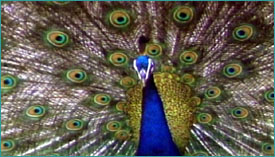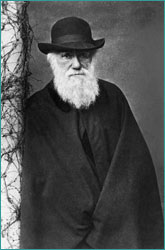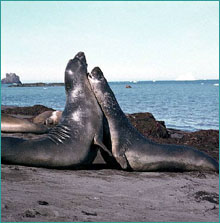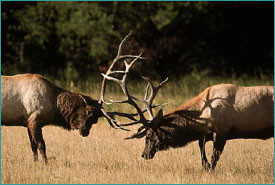 |
 |
|
|  The feathers that pestered Darwin
The feathers that pestered Darwin
|
Creature Courtship
by Peter Tyson
"The sight of a feather in a peacock's tail, whenever I gaze at it, makes me
sick!"
—Charles Darwin, in a letter to botanist Asa Gray, April 3, 1860
For most people, the glorious train of the peacock is a joy to behold. But
for Darwin in the years immediately following the 1859 publication of Origin
of Species, in which he laid out his theory of evolution by natural
selection, the peacock's resplendent train amounted to an eyesore.
For the father of evolution, baroque ornamentations like that train and other
seeming extravagances—such as the gaudy tailfin colors of the male guppy,
the saber rattling of the rutting bull elk, and the elaborate bowers of the
bowerbird—seemed to fly in the face of natural selection. How could such
ostentation, so costly to the creature in question in terms of expended time
and energy, benefit the animal and its offspring in the survival of the fittest?
 Darwin had
to devise an entirely new theory to explain the peacock's ostentatious
feathers.
Darwin had
to devise an entirely new theory to explain the peacock's ostentatious
feathers.
|
|
The other selection
In
the end, Darwin came up with an entirely new theory to explain the
extraordinary lengths many animals will go to in order to woo a potential mate.
He called it sexual selection. Simply put, sexual selection is the evolutionary
process that favors adaptations that increase an animal's chances of mating.
Darwin identified two kinds. In the first, males compete fiercely with each
other for access to females. This kind favors the evolution of secondary sexual
characters, such as large size and armaments like horns, that enhance a male's
ability to fight. In the second, males compete to win over a female. This
variety favors the evolution of vivid color patterns, intricate courtship
displays, and specialized structures such as plumes and frills, which heighten
a male's attractiveness to the opposite sex.
As we'll see, sexual selection is much more intense among males than among
females. The reason can be summed up in the phrase "sperm is cheap." Since
males bear an inexhaustible supply of sperm, it's in their interest to copulate
with as many females as possible, thereby engendering the most offspring. A
female, by contrast, has a limited cache of eggs. So as not to waste them on
less-than-ideal individuals, it pays for her to be discriminating.
That, in short, is why the feather that made Darwin sick belongs to the peacock
and not the peahen.
So what are some of the enhancements males invest in to court a potential mate?
As the following sampling will suggest, the range is limited only by the
imagination.
Clash of the titans
For males of many species, courtship begins with a thud. Crashing head-on into
one's rival—with painful and sometimes even lethal results—is the order
of the rutting day for many mammals bent on securing sexual favors from nearby
females.
|  Necks scarred from previous
battles, bull elephant seals fight it out on an Antarctic beach.
Necks scarred from previous
battles, bull elephant seals fight it out on an Antarctic beach.
|
One of the most fearsome of such battles occurs every spring among bull
elephant seals. The Sumo wrestlers of the animal world, male elephant seals are
quivering masses of blubber weighing up to 6,600 pounds. When they go at each
other, a pair of bulls rear up, roar loud enough to make the earth shake, and
collide with a thunderous crash. The whites of their bulbous eyes showing, they
gnash at each other's fleshy necks with blunt teeth that leave grievous-looking
wounds and nearby beach water stained crimson with blood. It's a dangerous
game, but the payoff is enormous. On islands off the Pacific coast of
California, for instance, beachmasters may control harems of 100-plus cows.
Males of other species prefer a show of force to force itself. The North
American elk is a good example. Bulls are big-shouldered beasts with majestic
sets of many-tined antlers. Come mating season, they start "bugling" for all
they're worth. This call starts as a bellow, quickly becomes a shrill whistle
or scream, and winds up with a series of grunts. The bull that calls the
longest and most frequently often succeeds in scaring off potential rivals with
his call alone. If challenged, however, he and his adversary walk in parallel
to show each other their "manly" profiles. If this doesn't convince one or the
other to back off, the pair resort to elephant-bull tactics and ram each
other.
 A pair of rutting bull elk lock
horns.
A pair of rutting bull elk lock
horns.
|
|
In rare instances, such jousts can cause serious injury or death. But typically
neither is hurt, for the elk's magnificent antlers, which originally did evolve
for fighting and defense, are now largely ornamental. An embellishment to
please the softer sex, the antlers are cast aside at the end of the rutting
season like ornaments after a holiday.
Continue: The meek shall inherit
Photo credits
On the Trail of the Bowerbird |
Are Bowers Art? |
Creature Courtship
Bowerbird Matching Game |
Resources |
Teacher's Guide
Transcript |
Site Map |
Flying Casanovas Home
Search |
Site Map |
Previously Featured |
Schedule |
Feedback |
Teachers |
Shop
Join Us/E-Mail |
About NOVA |
Editor's Picks |
Watch NOVAs online |
To print
PBS Online |
NOVA Online |
WGBH
© | Updated December 2001
|
|
|
|